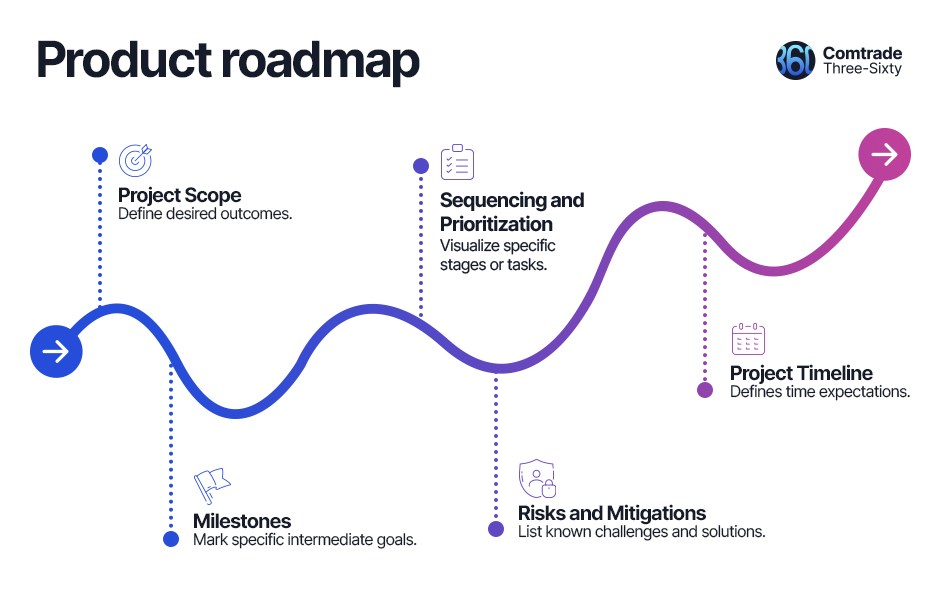How can we help?
Let’s talk about how we can help you transform your business.
Contact us
Software applications are known to age fast—it is common for an organization to use one for a year and then replace it with another. However, a paradoxical observation is that many successful applications tend to be in use much longer. A mission-critical, successful application can be in use even for a decade or two.
Aging applications are often challenged by shrinking usage or are becoming technologically outdated. Application modernization is an investment in improving software applications and systems that can address either or both pain points: improving user appeal and security, supportability, and scalability concerns.
As with any investment, it is very important to have a well-defined and understood vision of the intended result. It is also essential to create a common understanding among all participants on how the end vision is to be reached. Creating an application modernization roadmap is one of the most common tools for communicating steps toward the goal of application modernization.
In software development, a roadmap is a high-level plan that outlines the vision and goals for a software project over time. It is a shared document that captures:

Every project aims for a specific outcome, but software development goals can be hard to reach and far in the future. While planning a path to a distant goal will require adjustments during execution due to unforeseen issues or opportunities, a roadmap is one of the most valuable tools used in project management.
A roadmap provides a structure for the step-by-step evolution of the project’s progress, highlighting main goals, related progress markers, and execution strategies. By conducting thorough assessments and strategic planning, companies can maneuver through the intricacies of modernization by utilizing innovative technologies and methods to improve efficiency, strengthen security measures, and achieve sustainable growth.
While it is tempting to spend a lot of time upfront trying to identify and mitigate as many risks for the project as possible, our experience shows that prolonged planning investment has diminishing returns. After a while, delaying the start of an application modernization initiative has a bigger impact on the organization’s money flow than discovering and mitigating additional risks in the plan.
A roadmap is a document to inform every participant sufficiently to understand the project vision, the project’s goals, and the path to reaching those goals. A roadmap needs to communicate milestones to reach and provide visualization of dependencies for the upcoming project stages.
It is one of the best tools for gathering early feedback and calculating initial cost estimations, which is crucial for gaining the organization’s buy-in.
Project stages form a transformational path that needs to cover all aspects of the change. The most common project stages are onboarding contributors, defining target architecture, hardware or cloud provisioning, application transformation, data synchronization or data migrations, staged releases or general releases, consumer onboarding, and more.
In accordance with continuous delivery best practices, we highly recommend addressing quality and security requirements at every stage of the project rather than having separate stages defined for security and quality compliance.
Project milestones are built-in checks to see if the project is on track. Each milestone should define a set of criteria (or tests) that prove that the stage has been successfully completed. In many cases, those tests should be automated and reused to continuously monitor and ensure previous achievements are still available.
When one is creating a roadmap, the following steps are recommended:
We recommend identifying the most relevant pain points and opportunities the organization faces and assessing the business impact of each identified challenge. The result is a prioritized list of challenges the organization should resolve to improve its business effectiveness.
From the prioritized list of challenges impacting an organization, we recommend selecting only a few that will bring the biggest benefit. We recommend focusing on challenges that will improve competitive advantage and reduce the complexity of an organization’s daily operations.
While it is tempting to create one initiative to address as many challenges as the finances and available time allow, we highly recommend keeping any software development project small and focused on speed of completion instead. The benefits of reduced work-in-progress (WIP) are:
Once the project’s goals, scope, and priorities are known, the next step is to build the same understanding of the initiative’s vision, urgency, and priority.
Communicating the vision is also a great opportunity to gather early feedback. All questions and challenges to presented content are very welcome as they signal one of the following:
Early communication and alignment reduce re-work needed later and give time to the audience to accept the coming change, reducing resistance to change.
Milestones are intermediate goals for a software project that help reduce the management complexity of the whole initiative. Setting time boundaries should be postponed for a later stage once responsibilities are assigned and the availability of resources is negotiated.
Next, we recommend defining the dependencies, sequences, and priorities of intermediate goals. The project must then adapt to the financial, legal, security, market, cultural, and other limitations.
And third, we negotiate resource availability and assign responsibilities.
Once our initiative has a clear vision, goals, limitations, responsibilities, resources available, and a transformational approach is known, we can define an initial timeline.
Since every project contains a lot of uncertainty, we recommend creating a list of risks (with known and unknown causes) and preparing impact mitigation measures in case the risks are triggered. The most common measures are allocating additional time for reaching milestones with the highest risk, allocating additional resources, and creating a strategy that helps us re-negotiate priorities and the project scope.
Another of our recommendations is to create a project rollout plan that allows for incremental validation of work done and fast learning feedback loops that have minimal impact on business reputation and operations. The most popular techniques that can be used are quick prototyping, dark launches, A/B testing, and canary releases.
After completing the roadmap and the project plan, it is essential to establish ways to monitor the project’s progress continuously and adjust the plan as needed. This will require tracking project execution to ensure issues are discovered and addressed quickly and effectively. Regular interactions with application consumers can offer useful feedback about any challenge or opportunity that needs to be addressed by adjusting the plan.
Monitoring applications during the transformation for unusual behavior or performance deficiency is needed so issues can be addressed quickly before users or operations are impacted. In addition, it is essential to have plans in place to predict and handle any deviation from the project timeline to make necessary modifications and secure project advancement. By forming protective measures, we are ensuring that any challenges or opportunities raised from implementing adjustments can be managed appropriately.
An application modernization roadmap is very similar to a generic software development roadmap described above. However, additional circumstances need to be considered:
The amount of work required to complete application modernization is highly context-dependent. Thus, choosing an application modernization approach, technology stack, and other decisions will significantly affect project costs and timelines.
Pain points or opportunities to be addressed as described in the section “Start with Why” above will determine which application modernization approach to select from:
When assembling an IT solution for an organization, there are many options to evaluate and choose from. The flood of available frameworks, platforms, and technologies is already challenging. Still, once we also consider the volatility of the markets and the unpredictable lifetime of each component available, it becomes clear that every organization should optimize its operations for existential flexibility. One of the cornerstones of flexibility is an as-a-service mindset with a focus on value and monetary flow. At the same time, large investments and long-term commitments are considered a source of business risks.
We recommend public cloud platform usage. Even though many of the flexibility challenges can be addressed in multiple ways – we recommend choosing modern cloud platform technology as it is proving to be the most effective way of satisfying organizations’ IT needs. Most public clouds offer the following advantages:
Public cloud platform considerations:
Because of constant advances in technology, organizations must stay up to date with changes in technology and tools. Selecting the right approach and choosing a good strategy can avoid many challenges. Trends like cloud, microservices architecture, containerization, DevOps approach, and IoT empower organizations to adjust their operations quickly, which provides leverage to stay competitive against other solutions that do not have such scalability, flexibility, and cost efficiency.
An essential influence on the future of application modernization is the ever-increasing involvement of process automation and artificial intelligence. Powerful tools can assist in application modernization by improving the speed and quality of decision-making, ensuring security compliance, and even helping transform legacy application code.
In summary, the evolution of modernization applications is marked by a blend of cloud-based tools, automated processes, artificial intelligence, DevOps methods, connecting with devices, and implementing security protocols. Embracing these advancements allows companies to remain creative and provide top-notch digital interactions for their clients while adapting to a constantly changing tech environment. Explore our application modernization solutions to see how you can transform your business for the digital age.